BUS300: Organizational Analysis - Case Study of Apple Inc.
VerifiedAdded on 2022/01/25
|14
|3357
|573
Report
AI Summary
This report presents an organizational analysis of Apple Inc., examining its internal and external strategic factors. It delves into Apple's organizational structure, highlighting its spoke-and-wheel hierarchy, function-based grouping, and product-based grouping. The analysis identifies Apple's strengths, such as its globally recognized brand image, high-profit margins, and effective innovation process, while also acknowledging its weaknesses, including a limited distribution network and high selling prices. The report further explores opportunities for Apple, such as distribution network expansion and rising demand for its products. A SWOT analysis is employed to assess these factors, providing insights into Apple's strategic direction and market position. The report emphasizes the impact of these factors on Apple's success, innovation, and ability to maintain its competitive edge in the technology industry. The analysis underscores the importance of understanding both internal capabilities and external market dynamics for sustained business growth and investor evaluation.
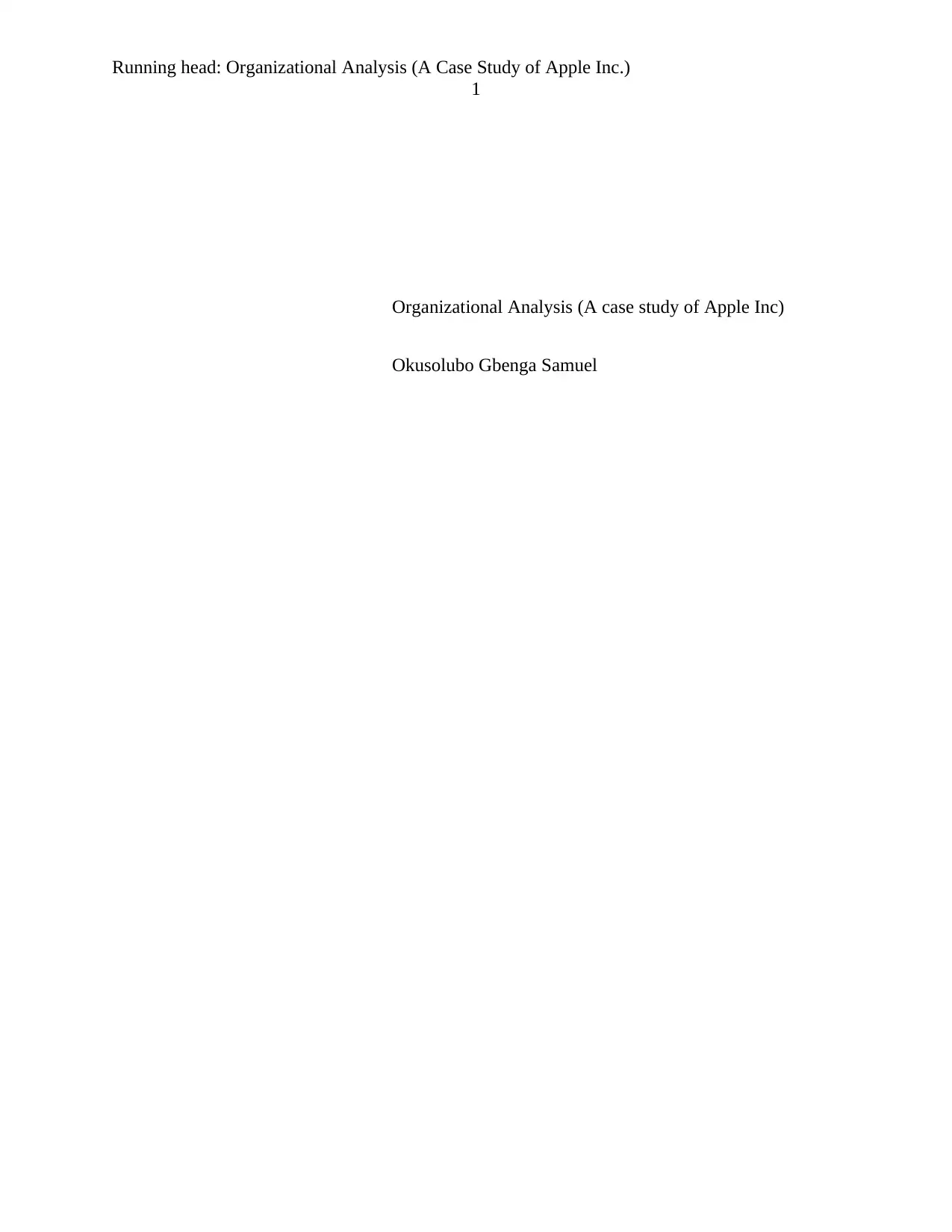
Running head: Organizational Analysis (A Case Study of Apple Inc.)
1
Organizational Analysis (A case study of Apple Inc)
Okusolubo Gbenga Samuel
1
Organizational Analysis (A case study of Apple Inc)
Okusolubo Gbenga Samuel
Paraphrase This Document
Need a fresh take? Get an instant paraphrase of this document with our AI Paraphraser
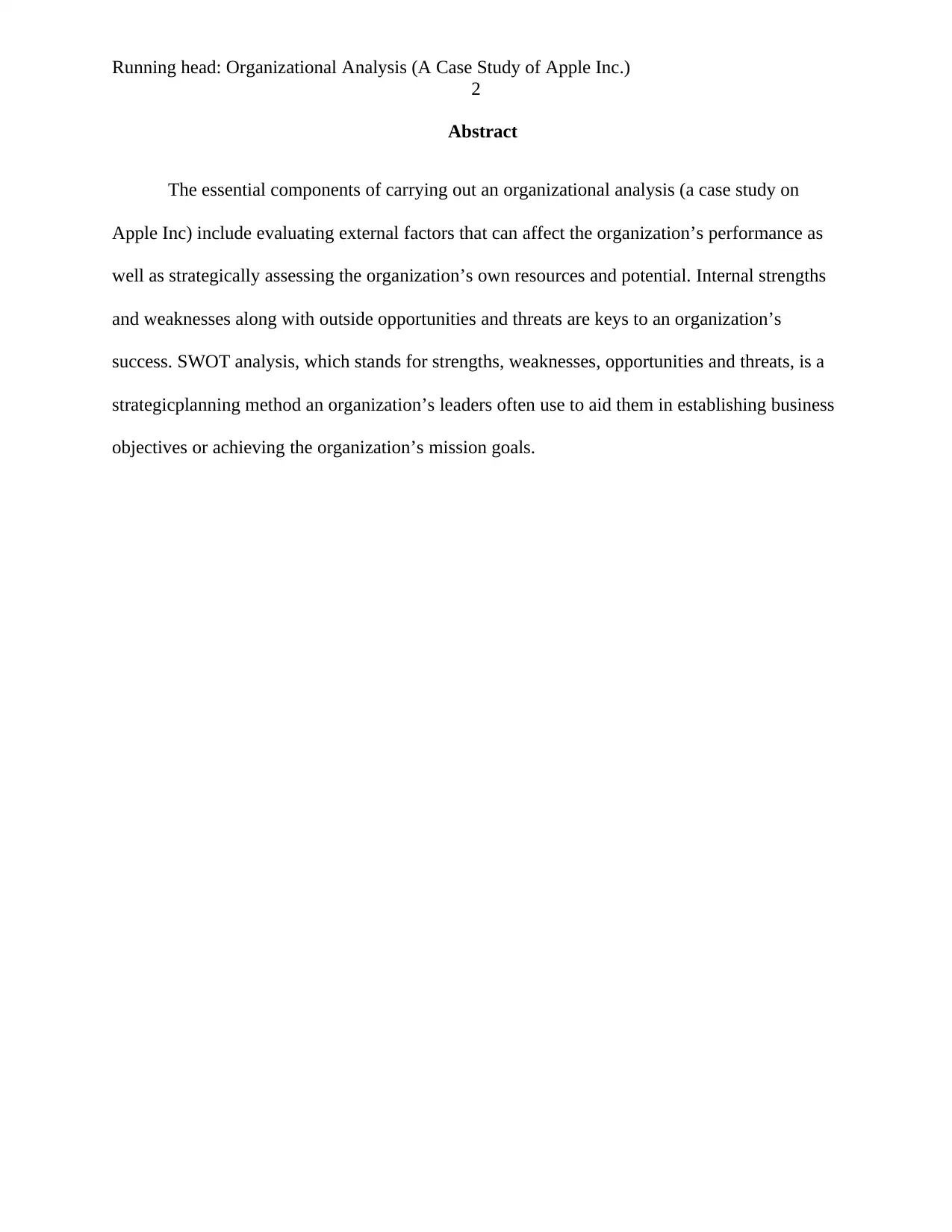
Running head: Organizational Analysis (A Case Study of Apple Inc.)
2
Abstract
The essential components of carrying out an organizational analysis (a case study on
Apple Inc) include evaluating external factors that can affect the organization’s performance as
well as strategically assessing the organization’s own resources and potential. Internal strengths
and weaknesses along with outside opportunities and threats are keys to an organization’s
success. SWOT analysis, which stands for strengths, weaknesses, opportunities and threats, is a
strategicplanning method an organization’s leaders often use to aid them in establishing business
objectives or achieving the organization’s mission goals.
2
Abstract
The essential components of carrying out an organizational analysis (a case study on
Apple Inc) include evaluating external factors that can affect the organization’s performance as
well as strategically assessing the organization’s own resources and potential. Internal strengths
and weaknesses along with outside opportunities and threats are keys to an organization’s
success. SWOT analysis, which stands for strengths, weaknesses, opportunities and threats, is a
strategicplanning method an organization’s leaders often use to aid them in establishing business
objectives or achieving the organization’s mission goals.
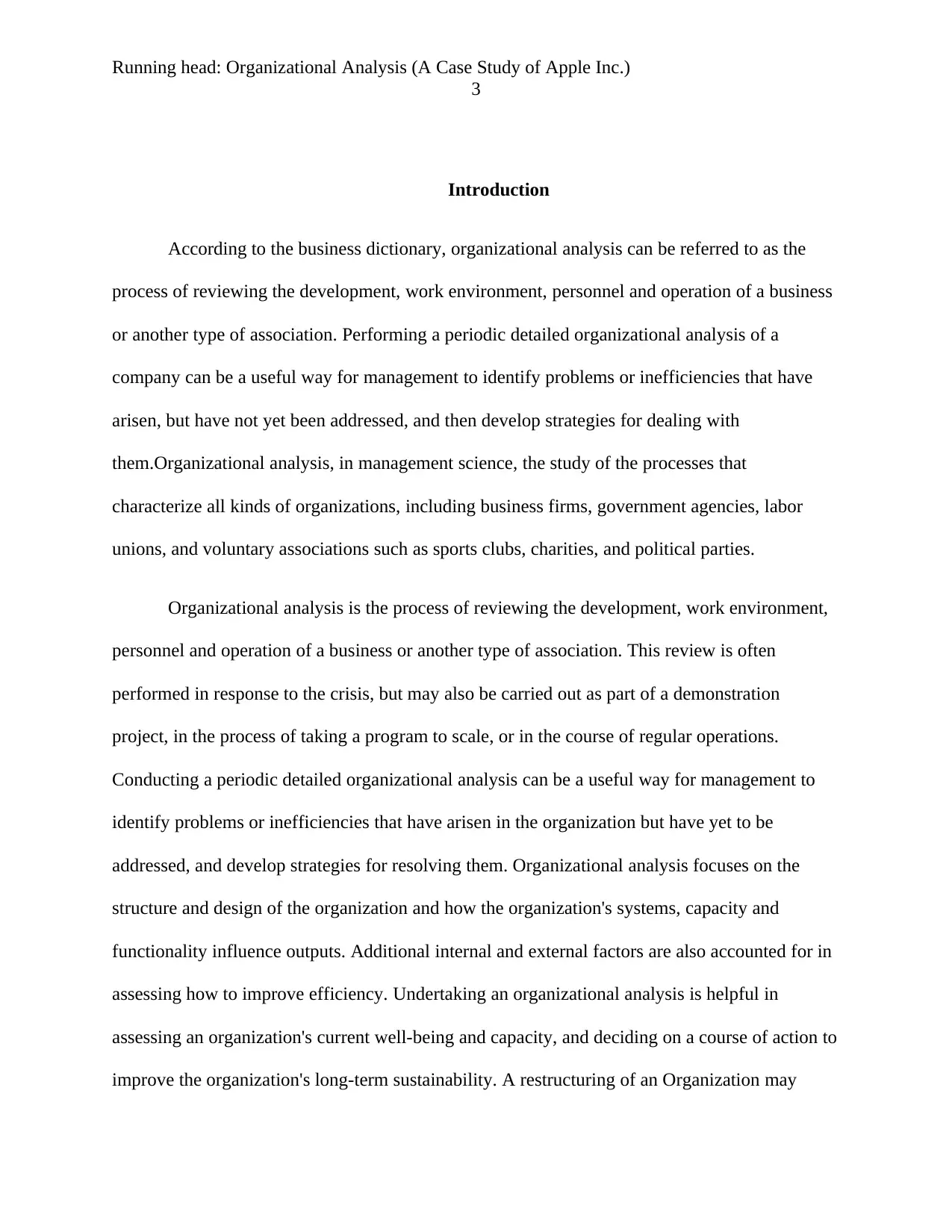
Running head: Organizational Analysis (A Case Study of Apple Inc.)
3
Introduction
According to the business dictionary, organizational analysis can be referred to as the
process of reviewing the development, work environment, personnel and operation of a business
or another type of association. Performing a periodic detailed organizational analysis of a
company can be a useful way for management to identify problems or inefficiencies that have
arisen, but have not yet been addressed, and then develop strategies for dealing with
them.Organizational analysis, in management science, the study of the processes that
characterize all kinds of organizations, including business firms, government agencies, labor
unions, and voluntary associations such as sports clubs, charities, and political parties.
Organizational analysis is the process of reviewing the development, work environment,
personnel and operation of a business or another type of association. This review is often
performed in response to the crisis, but may also be carried out as part of a demonstration
project, in the process of taking a program to scale, or in the course of regular operations.
Conducting a periodic detailed organizational analysis can be a useful way for management to
identify problems or inefficiencies that have arisen in the organization but have yet to be
addressed, and develop strategies for resolving them. Organizational analysis focuses on the
structure and design of the organization and how the organization's systems, capacity and
functionality influence outputs. Additional internal and external factors are also accounted for in
assessing how to improve efficiency. Undertaking an organizational analysis is helpful in
assessing an organization's current well-being and capacity, and deciding on a course of action to
improve the organization's long-term sustainability. A restructuring of an Organization may
3
Introduction
According to the business dictionary, organizational analysis can be referred to as the
process of reviewing the development, work environment, personnel and operation of a business
or another type of association. Performing a periodic detailed organizational analysis of a
company can be a useful way for management to identify problems or inefficiencies that have
arisen, but have not yet been addressed, and then develop strategies for dealing with
them.Organizational analysis, in management science, the study of the processes that
characterize all kinds of organizations, including business firms, government agencies, labor
unions, and voluntary associations such as sports clubs, charities, and political parties.
Organizational analysis is the process of reviewing the development, work environment,
personnel and operation of a business or another type of association. This review is often
performed in response to the crisis, but may also be carried out as part of a demonstration
project, in the process of taking a program to scale, or in the course of regular operations.
Conducting a periodic detailed organizational analysis can be a useful way for management to
identify problems or inefficiencies that have arisen in the organization but have yet to be
addressed, and develop strategies for resolving them. Organizational analysis focuses on the
structure and design of the organization and how the organization's systems, capacity and
functionality influence outputs. Additional internal and external factors are also accounted for in
assessing how to improve efficiency. Undertaking an organizational analysis is helpful in
assessing an organization's current well-being and capacity, and deciding on a course of action to
improve the organization's long-term sustainability. A restructuring of an Organization may
⊘ This is a preview!⊘
Do you want full access?
Subscribe today to unlock all pages.

Trusted by 1+ million students worldwide
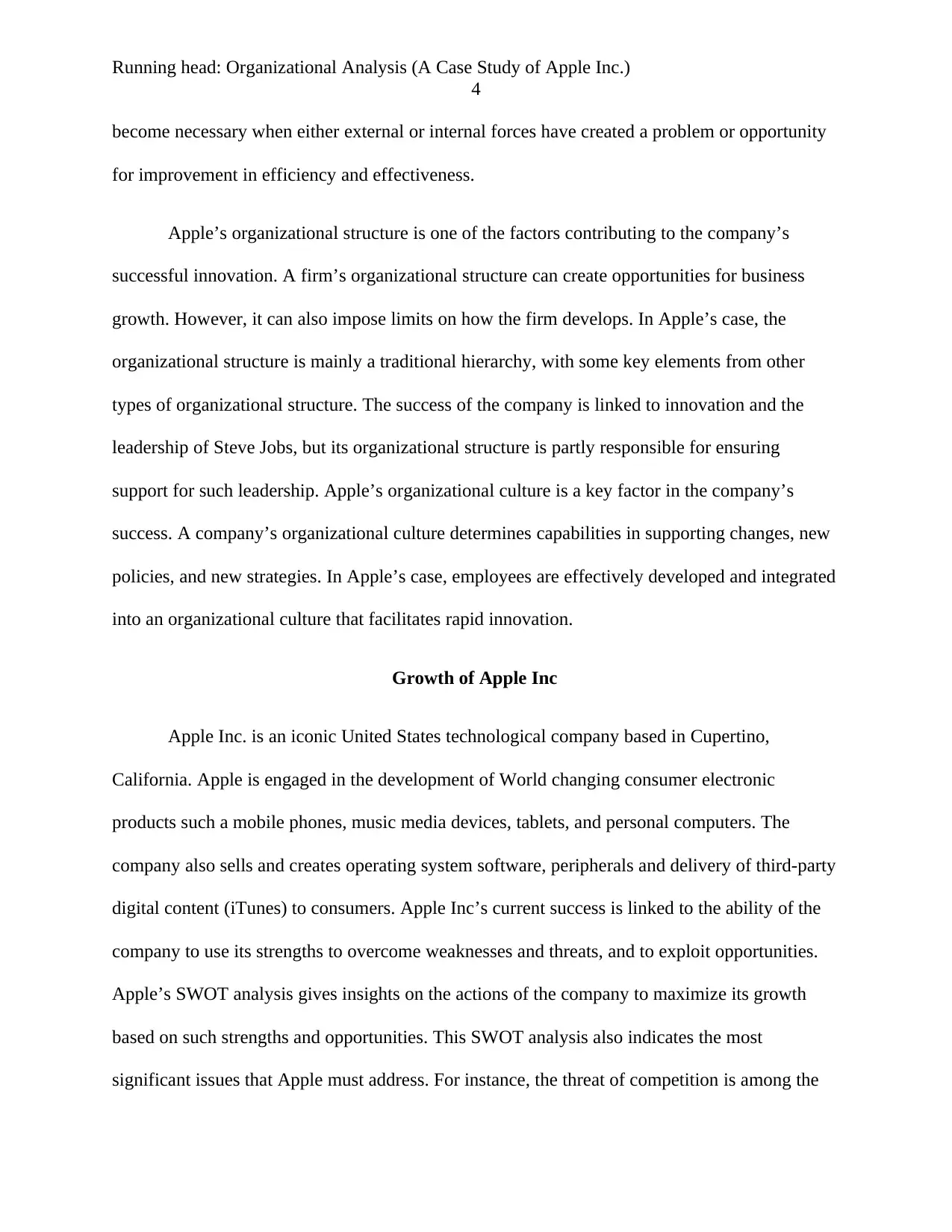
Running head: Organizational Analysis (A Case Study of Apple Inc.)
4
become necessary when either external or internal forces have created a problem or opportunity
for improvement in efficiency and effectiveness.
Apple’s organizational structure is one of the factors contributing to the company’s
successful innovation. A firm’s organizational structure can create opportunities for business
growth. However, it can also impose limits on how the firm develops. In Apple’s case, the
organizational structure is mainly a traditional hierarchy, with some key elements from other
types of organizational structure. The success of the company is linked to innovation and the
leadership of Steve Jobs, but its organizational structure is partly responsible for ensuring
support for such leadership. Apple’s organizational culture is a key factor in the company’s
success. A company’s organizational culture determines capabilities in supporting changes, new
policies, and new strategies. In Apple’s case, employees are effectively developed and integrated
into an organizational culture that facilitates rapid innovation.
Growth of Apple Inc
Apple Inc. is an iconic United States technological company based in Cupertino,
California. Apple is engaged in the development of World changing consumer electronic
products such a mobile phones, music media devices, tablets, and personal computers. The
company also sells and creates operating system software, peripherals and delivery of third-party
digital content (iTunes) to consumers. Apple Inc’s current success is linked to the ability of the
company to use its strengths to overcome weaknesses and threats, and to exploit opportunities.
Apple’s SWOT analysis gives insights on the actions of the company to maximize its growth
based on such strengths and opportunities. This SWOT analysis also indicates the most
significant issues that Apple must address. For instance, the threat of competition is among the
4
become necessary when either external or internal forces have created a problem or opportunity
for improvement in efficiency and effectiveness.
Apple’s organizational structure is one of the factors contributing to the company’s
successful innovation. A firm’s organizational structure can create opportunities for business
growth. However, it can also impose limits on how the firm develops. In Apple’s case, the
organizational structure is mainly a traditional hierarchy, with some key elements from other
types of organizational structure. The success of the company is linked to innovation and the
leadership of Steve Jobs, but its organizational structure is partly responsible for ensuring
support for such leadership. Apple’s organizational culture is a key factor in the company’s
success. A company’s organizational culture determines capabilities in supporting changes, new
policies, and new strategies. In Apple’s case, employees are effectively developed and integrated
into an organizational culture that facilitates rapid innovation.
Growth of Apple Inc
Apple Inc. is an iconic United States technological company based in Cupertino,
California. Apple is engaged in the development of World changing consumer electronic
products such a mobile phones, music media devices, tablets, and personal computers. The
company also sells and creates operating system software, peripherals and delivery of third-party
digital content (iTunes) to consumers. Apple Inc’s current success is linked to the ability of the
company to use its strengths to overcome weaknesses and threats, and to exploit opportunities.
Apple’s SWOT analysis gives insights on the actions of the company to maximize its growth
based on such strengths and opportunities. This SWOT analysis also indicates the most
significant issues that Apple must address. For instance, the threat of competition is among the
Paraphrase This Document
Need a fresh take? Get an instant paraphrase of this document with our AI Paraphraser
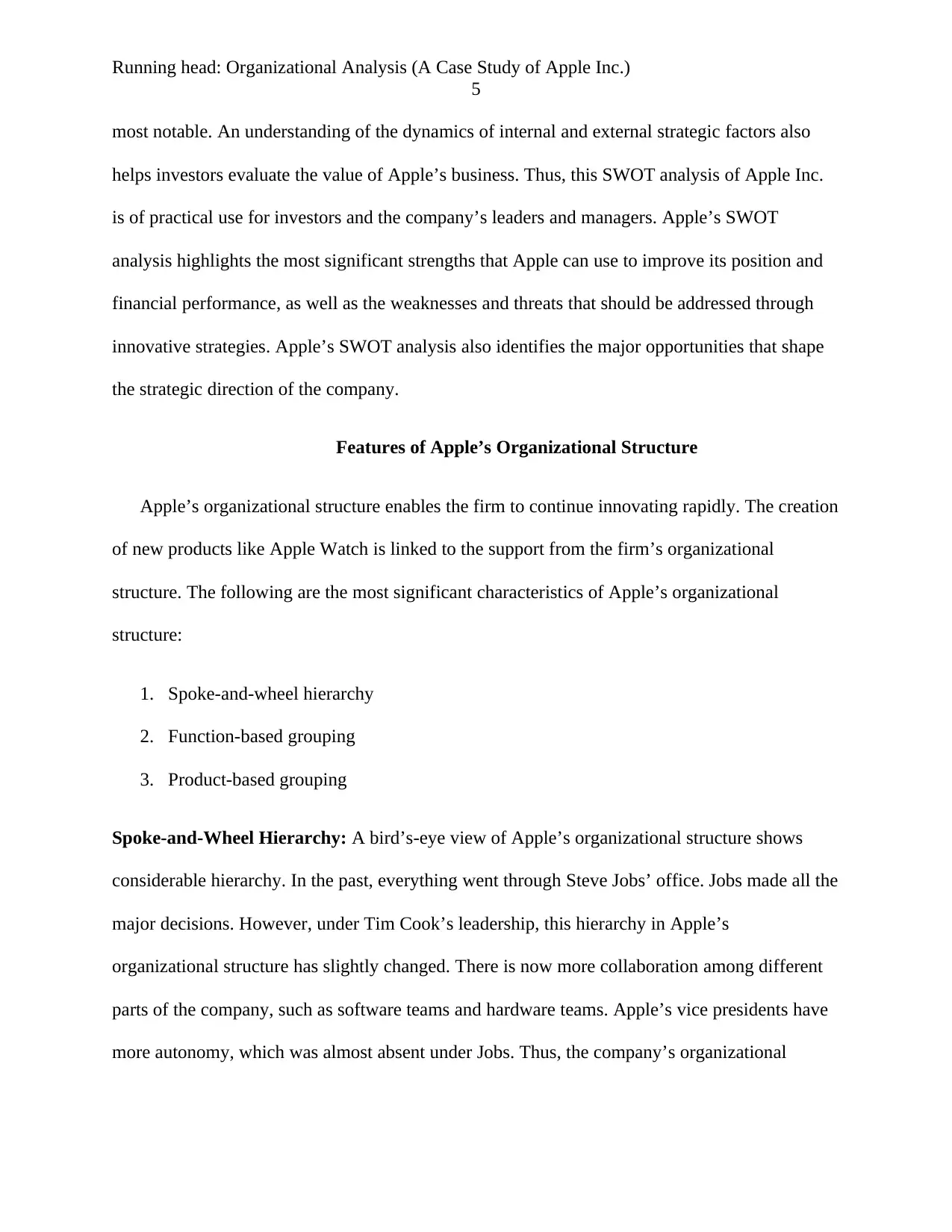
Running head: Organizational Analysis (A Case Study of Apple Inc.)
5
most notable. An understanding of the dynamics of internal and external strategic factors also
helps investors evaluate the value of Apple’s business. Thus, this SWOT analysis of Apple Inc.
is of practical use for investors and the company’s leaders and managers. Apple’s SWOT
analysis highlights the most significant strengths that Apple can use to improve its position and
financial performance, as well as the weaknesses and threats that should be addressed through
innovative strategies. Apple’s SWOT analysis also identifies the major opportunities that shape
the strategic direction of the company.
Features of Apple’s Organizational Structure
Apple’s organizational structure enables the firm to continue innovating rapidly. The creation
of new products like Apple Watch is linked to the support from the firm’s organizational
structure. The following are the most significant characteristics of Apple’s organizational
structure:
1. Spoke-and-wheel hierarchy
2. Function-based grouping
3. Product-based grouping
Spoke-and-Wheel Hierarchy: A bird’s-eye view of Apple’s organizational structure shows
considerable hierarchy. In the past, everything went through Steve Jobs’ office. Jobs made all the
major decisions. However, under Tim Cook’s leadership, this hierarchy in Apple’s
organizational structure has slightly changed. There is now more collaboration among different
parts of the company, such as software teams and hardware teams. Apple’s vice presidents have
more autonomy, which was almost absent under Jobs. Thus, the company’s organizational
5
most notable. An understanding of the dynamics of internal and external strategic factors also
helps investors evaluate the value of Apple’s business. Thus, this SWOT analysis of Apple Inc.
is of practical use for investors and the company’s leaders and managers. Apple’s SWOT
analysis highlights the most significant strengths that Apple can use to improve its position and
financial performance, as well as the weaknesses and threats that should be addressed through
innovative strategies. Apple’s SWOT analysis also identifies the major opportunities that shape
the strategic direction of the company.
Features of Apple’s Organizational Structure
Apple’s organizational structure enables the firm to continue innovating rapidly. The creation
of new products like Apple Watch is linked to the support from the firm’s organizational
structure. The following are the most significant characteristics of Apple’s organizational
structure:
1. Spoke-and-wheel hierarchy
2. Function-based grouping
3. Product-based grouping
Spoke-and-Wheel Hierarchy: A bird’s-eye view of Apple’s organizational structure shows
considerable hierarchy. In the past, everything went through Steve Jobs’ office. Jobs made all the
major decisions. However, under Tim Cook’s leadership, this hierarchy in Apple’s
organizational structure has slightly changed. There is now more collaboration among different
parts of the company, such as software teams and hardware teams. Apple’s vice presidents have
more autonomy, which was almost absent under Jobs. Thus, the company’s organizational
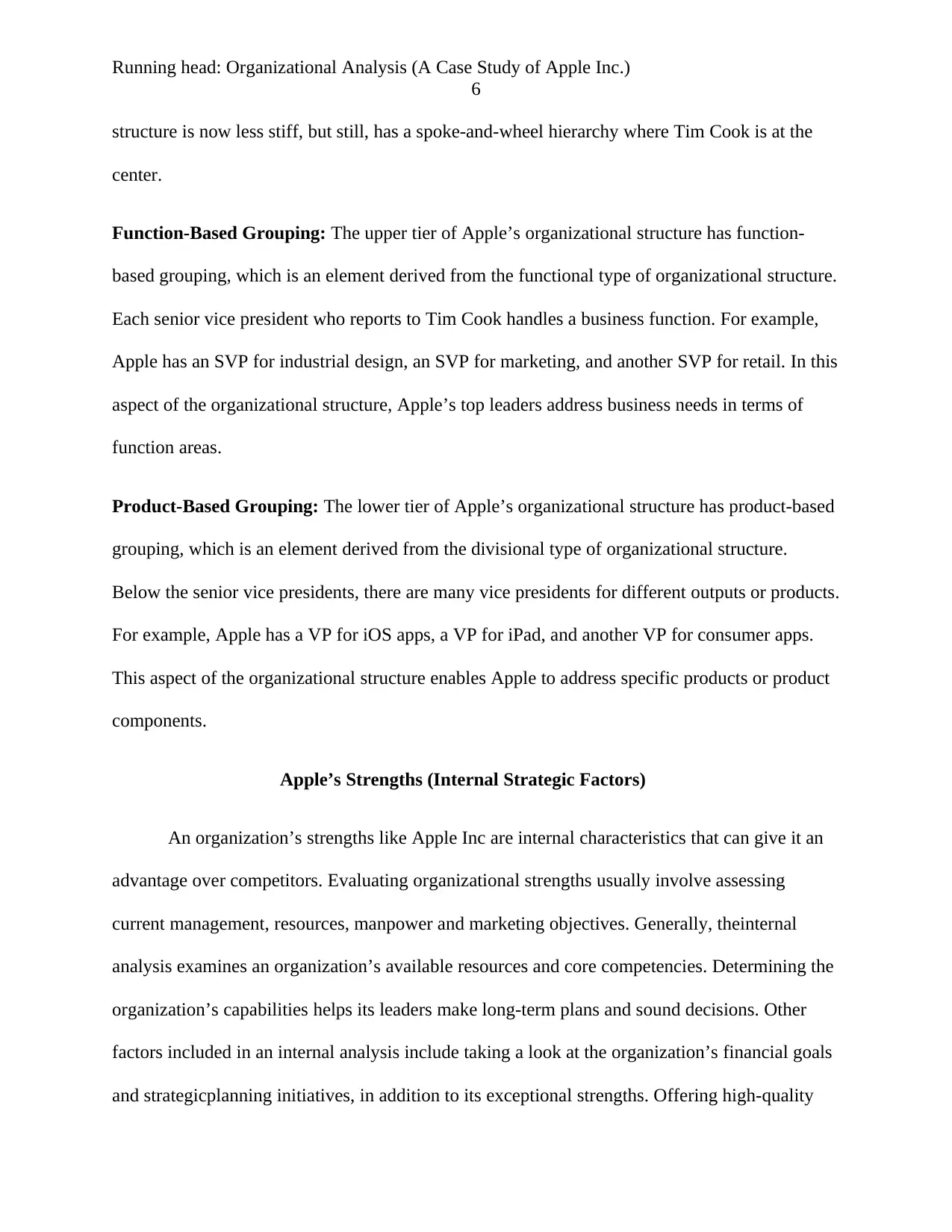
Running head: Organizational Analysis (A Case Study of Apple Inc.)
6
structure is now less stiff, but still, has a spoke-and-wheel hierarchy where Tim Cook is at the
center.
Function-Based Grouping: The upper tier of Apple’s organizational structure has function-
based grouping, which is an element derived from the functional type of organizational structure.
Each senior vice president who reports to Tim Cook handles a business function. For example,
Apple has an SVP for industrial design, an SVP for marketing, and another SVP for retail. In this
aspect of the organizational structure, Apple’s top leaders address business needs in terms of
function areas.
Product-Based Grouping: The lower tier of Apple’s organizational structure has product-based
grouping, which is an element derived from the divisional type of organizational structure.
Below the senior vice presidents, there are many vice presidents for different outputs or products.
For example, Apple has a VP for iOS apps, a VP for iPad, and another VP for consumer apps.
This aspect of the organizational structure enables Apple to address specific products or product
components.
Apple’s Strengths (Internal Strategic Factors)
An organization’s strengths like Apple Inc are internal characteristics that can give it an
advantage over competitors. Evaluating organizational strengths usually involve assessing
current management, resources, manpower and marketing objectives. Generally, theinternal
analysis examines an organization’s available resources and core competencies. Determining the
organization’s capabilities helps its leaders make long-term plans and sound decisions. Other
factors included in an internal analysis include taking a look at the organization’s financial goals
and strategicplanning initiatives, in addition to its exceptional strengths. Offering high-quality
6
structure is now less stiff, but still, has a spoke-and-wheel hierarchy where Tim Cook is at the
center.
Function-Based Grouping: The upper tier of Apple’s organizational structure has function-
based grouping, which is an element derived from the functional type of organizational structure.
Each senior vice president who reports to Tim Cook handles a business function. For example,
Apple has an SVP for industrial design, an SVP for marketing, and another SVP for retail. In this
aspect of the organizational structure, Apple’s top leaders address business needs in terms of
function areas.
Product-Based Grouping: The lower tier of Apple’s organizational structure has product-based
grouping, which is an element derived from the divisional type of organizational structure.
Below the senior vice presidents, there are many vice presidents for different outputs or products.
For example, Apple has a VP for iOS apps, a VP for iPad, and another VP for consumer apps.
This aspect of the organizational structure enables Apple to address specific products or product
components.
Apple’s Strengths (Internal Strategic Factors)
An organization’s strengths like Apple Inc are internal characteristics that can give it an
advantage over competitors. Evaluating organizational strengths usually involve assessing
current management, resources, manpower and marketing objectives. Generally, theinternal
analysis examines an organization’s available resources and core competencies. Determining the
organization’s capabilities helps its leaders make long-term plans and sound decisions. Other
factors included in an internal analysis include taking a look at the organization’s financial goals
and strategicplanning initiatives, in addition to its exceptional strengths. Offering high-quality
⊘ This is a preview!⊘
Do you want full access?
Subscribe today to unlock all pages.

Trusted by 1+ million students worldwide
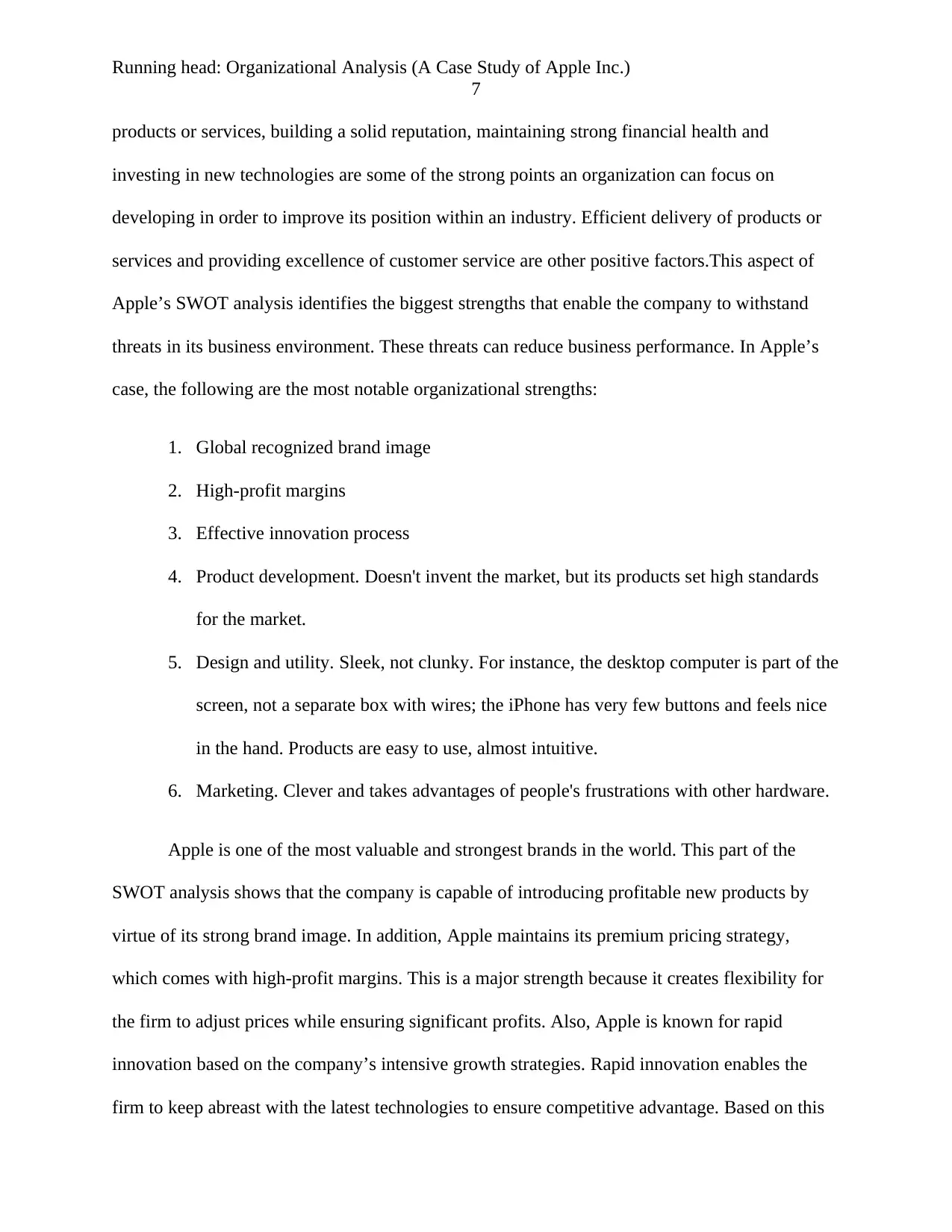
Running head: Organizational Analysis (A Case Study of Apple Inc.)
7
products or services, building a solid reputation, maintaining strong financial health and
investing in new technologies are some of the strong points an organization can focus on
developing in order to improve its position within an industry. Efficient delivery of products or
services and providing excellence of customer service are other positive factors.This aspect of
Apple’s SWOT analysis identifies the biggest strengths that enable the company to withstand
threats in its business environment. These threats can reduce business performance. In Apple’s
case, the following are the most notable organizational strengths:
1. Global recognized brand image
2. High-profit margins
3. Effective innovation process
4. Product development. Doesn't invent the market, but its products set high standards
for the market.
5. Design and utility. Sleek, not clunky. For instance, the desktop computer is part of the
screen, not a separate box with wires; the iPhone has very few buttons and feels nice
in the hand. Products are easy to use, almost intuitive.
6. Marketing. Clever and takes advantages of people's frustrations with other hardware.
Apple is one of the most valuable and strongest brands in the world. This part of the
SWOT analysis shows that the company is capable of introducing profitable new products by
virtue of its strong brand image. In addition, Apple maintains its premium pricing strategy,
which comes with high-profit margins. This is a major strength because it creates flexibility for
the firm to adjust prices while ensuring significant profits. Also, Apple is known for rapid
innovation based on the company’s intensive growth strategies. Rapid innovation enables the
firm to keep abreast with the latest technologies to ensure competitive advantage. Based on this
7
products or services, building a solid reputation, maintaining strong financial health and
investing in new technologies are some of the strong points an organization can focus on
developing in order to improve its position within an industry. Efficient delivery of products or
services and providing excellence of customer service are other positive factors.This aspect of
Apple’s SWOT analysis identifies the biggest strengths that enable the company to withstand
threats in its business environment. These threats can reduce business performance. In Apple’s
case, the following are the most notable organizational strengths:
1. Global recognized brand image
2. High-profit margins
3. Effective innovation process
4. Product development. Doesn't invent the market, but its products set high standards
for the market.
5. Design and utility. Sleek, not clunky. For instance, the desktop computer is part of the
screen, not a separate box with wires; the iPhone has very few buttons and feels nice
in the hand. Products are easy to use, almost intuitive.
6. Marketing. Clever and takes advantages of people's frustrations with other hardware.
Apple is one of the most valuable and strongest brands in the world. This part of the
SWOT analysis shows that the company is capable of introducing profitable new products by
virtue of its strong brand image. In addition, Apple maintains its premium pricing strategy,
which comes with high-profit margins. This is a major strength because it creates flexibility for
the firm to adjust prices while ensuring significant profits. Also, Apple is known for rapid
innovation based on the company’s intensive growth strategies. Rapid innovation enables the
firm to keep abreast with the latest technologies to ensure competitive advantage. Based on this
Paraphrase This Document
Need a fresh take? Get an instant paraphrase of this document with our AI Paraphraser
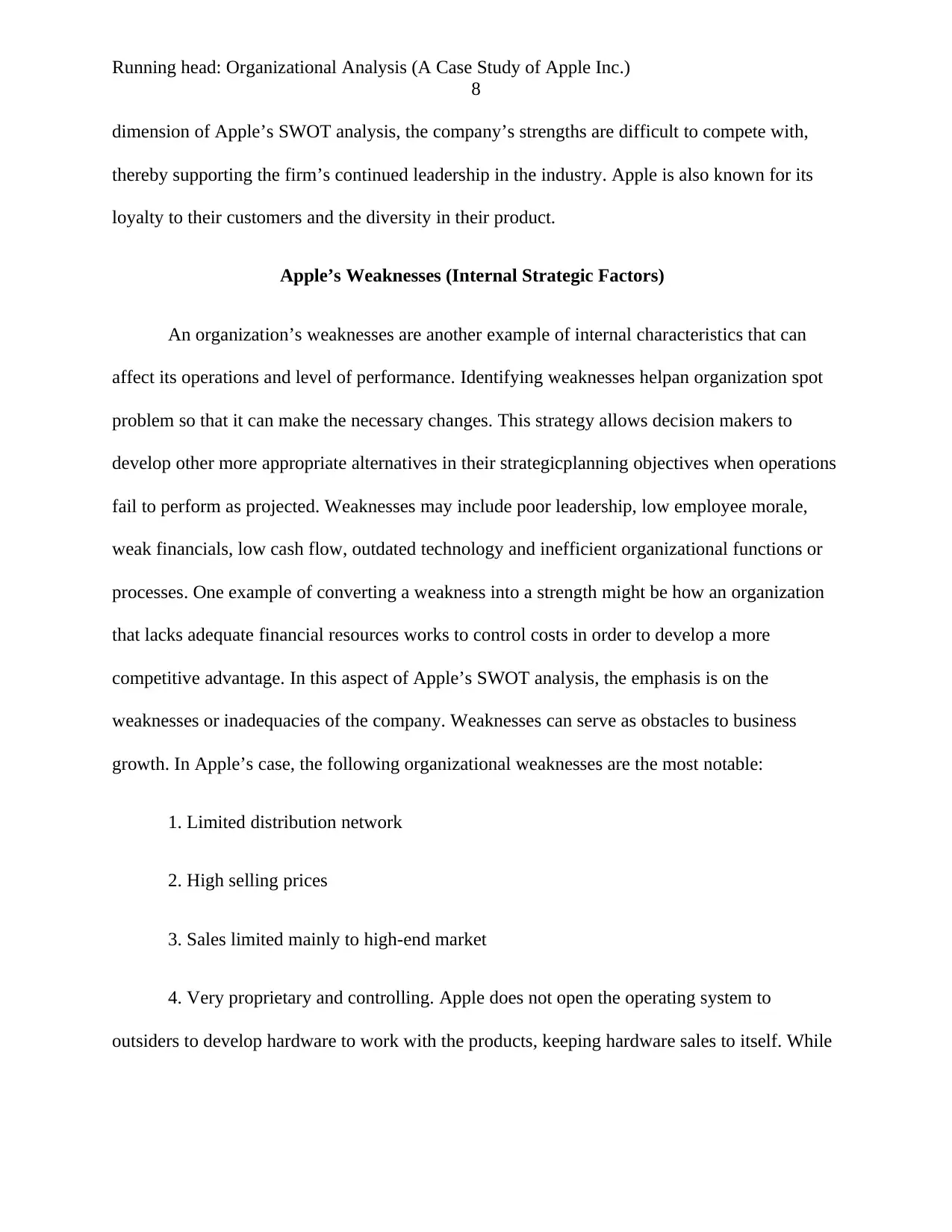
Running head: Organizational Analysis (A Case Study of Apple Inc.)
8
dimension of Apple’s SWOT analysis, the company’s strengths are difficult to compete with,
thereby supporting the firm’s continued leadership in the industry. Apple is also known for its
loyalty to their customers and the diversity in their product.
Apple’s Weaknesses (Internal Strategic Factors)
An organization’s weaknesses are another example of internal characteristics that can
affect its operations and level of performance. Identifying weaknesses helpan organization spot
problem so that it can make the necessary changes. This strategy allows decision makers to
develop other more appropriate alternatives in their strategicplanning objectives when operations
fail to perform as projected. Weaknesses may include poor leadership, low employee morale,
weak financials, low cash flow, outdated technology and inefficient organizational functions or
processes. One example of converting a weakness into a strength might be how an organization
that lacks adequate financial resources works to control costs in order to develop a more
competitive advantage. In this aspect of Apple’s SWOT analysis, the emphasis is on the
weaknesses or inadequacies of the company. Weaknesses can serve as obstacles to business
growth. In Apple’s case, the following organizational weaknesses are the most notable:
1. Limited distribution network
2. High selling prices
3. Sales limited mainly to high-end market
4. Very proprietary and controlling. Apple does not open the operating system to
outsiders to develop hardware to work with the products, keeping hardware sales to itself. While
8
dimension of Apple’s SWOT analysis, the company’s strengths are difficult to compete with,
thereby supporting the firm’s continued leadership in the industry. Apple is also known for its
loyalty to their customers and the diversity in their product.
Apple’s Weaknesses (Internal Strategic Factors)
An organization’s weaknesses are another example of internal characteristics that can
affect its operations and level of performance. Identifying weaknesses helpan organization spot
problem so that it can make the necessary changes. This strategy allows decision makers to
develop other more appropriate alternatives in their strategicplanning objectives when operations
fail to perform as projected. Weaknesses may include poor leadership, low employee morale,
weak financials, low cash flow, outdated technology and inefficient organizational functions or
processes. One example of converting a weakness into a strength might be how an organization
that lacks adequate financial resources works to control costs in order to develop a more
competitive advantage. In this aspect of Apple’s SWOT analysis, the emphasis is on the
weaknesses or inadequacies of the company. Weaknesses can serve as obstacles to business
growth. In Apple’s case, the following organizational weaknesses are the most notable:
1. Limited distribution network
2. High selling prices
3. Sales limited mainly to high-end market
4. Very proprietary and controlling. Apple does not open the operating system to
outsiders to develop hardware to work with the products, keeping hardware sales to itself. While
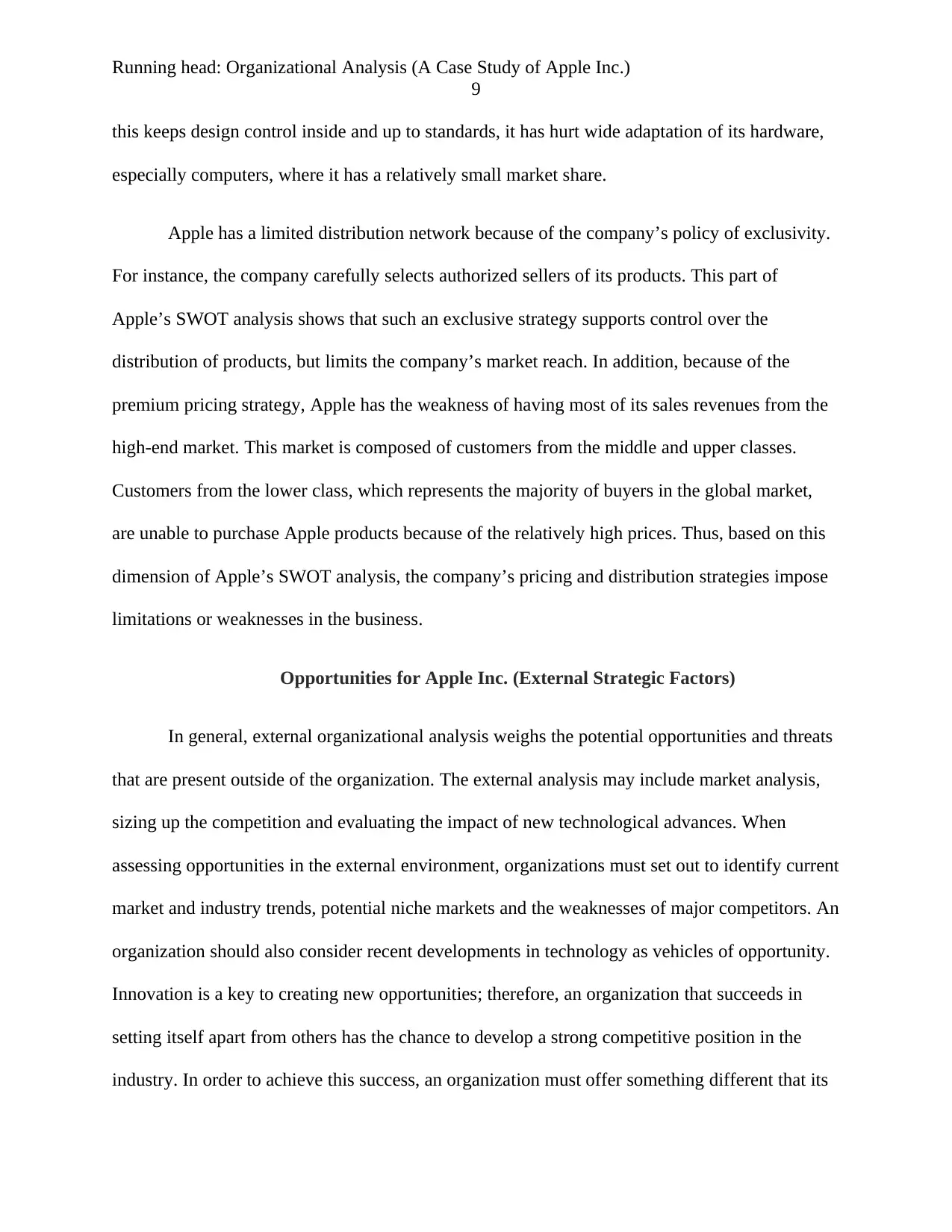
Running head: Organizational Analysis (A Case Study of Apple Inc.)
9
this keeps design control inside and up to standards, it has hurt wide adaptation of its hardware,
especially computers, where it has a relatively small market share.
Apple has a limited distribution network because of the company’s policy of exclusivity.
For instance, the company carefully selects authorized sellers of its products. This part of
Apple’s SWOT analysis shows that such an exclusive strategy supports control over the
distribution of products, but limits the company’s market reach. In addition, because of the
premium pricing strategy, Apple has the weakness of having most of its sales revenues from the
high-end market. This market is composed of customers from the middle and upper classes.
Customers from the lower class, which represents the majority of buyers in the global market,
are unable to purchase Apple products because of the relatively high prices. Thus, based on this
dimension of Apple’s SWOT analysis, the company’s pricing and distribution strategies impose
limitations or weaknesses in the business.
Opportunities for Apple Inc. (External Strategic Factors)
In general, external organizational analysis weighs the potential opportunities and threats
that are present outside of the organization. The external analysis may include market analysis,
sizing up the competition and evaluating the impact of new technological advances. When
assessing opportunities in the external environment, organizations must set out to identify current
market and industry trends, potential niche markets and the weaknesses of major competitors. An
organization should also consider recent developments in technology as vehicles of opportunity.
Innovation is a key to creating new opportunities; therefore, an organization that succeeds in
setting itself apart from others has the chance to develop a strong competitive position in the
industry. In order to achieve this success, an organization must offer something different that its
9
this keeps design control inside and up to standards, it has hurt wide adaptation of its hardware,
especially computers, where it has a relatively small market share.
Apple has a limited distribution network because of the company’s policy of exclusivity.
For instance, the company carefully selects authorized sellers of its products. This part of
Apple’s SWOT analysis shows that such an exclusive strategy supports control over the
distribution of products, but limits the company’s market reach. In addition, because of the
premium pricing strategy, Apple has the weakness of having most of its sales revenues from the
high-end market. This market is composed of customers from the middle and upper classes.
Customers from the lower class, which represents the majority of buyers in the global market,
are unable to purchase Apple products because of the relatively high prices. Thus, based on this
dimension of Apple’s SWOT analysis, the company’s pricing and distribution strategies impose
limitations or weaknesses in the business.
Opportunities for Apple Inc. (External Strategic Factors)
In general, external organizational analysis weighs the potential opportunities and threats
that are present outside of the organization. The external analysis may include market analysis,
sizing up the competition and evaluating the impact of new technological advances. When
assessing opportunities in the external environment, organizations must set out to identify current
market and industry trends, potential niche markets and the weaknesses of major competitors. An
organization should also consider recent developments in technology as vehicles of opportunity.
Innovation is a key to creating new opportunities; therefore, an organization that succeeds in
setting itself apart from others has the chance to develop a strong competitive position in the
industry. In order to achieve this success, an organization must offer something different that its
⊘ This is a preview!⊘
Do you want full access?
Subscribe today to unlock all pages.

Trusted by 1+ million students worldwide
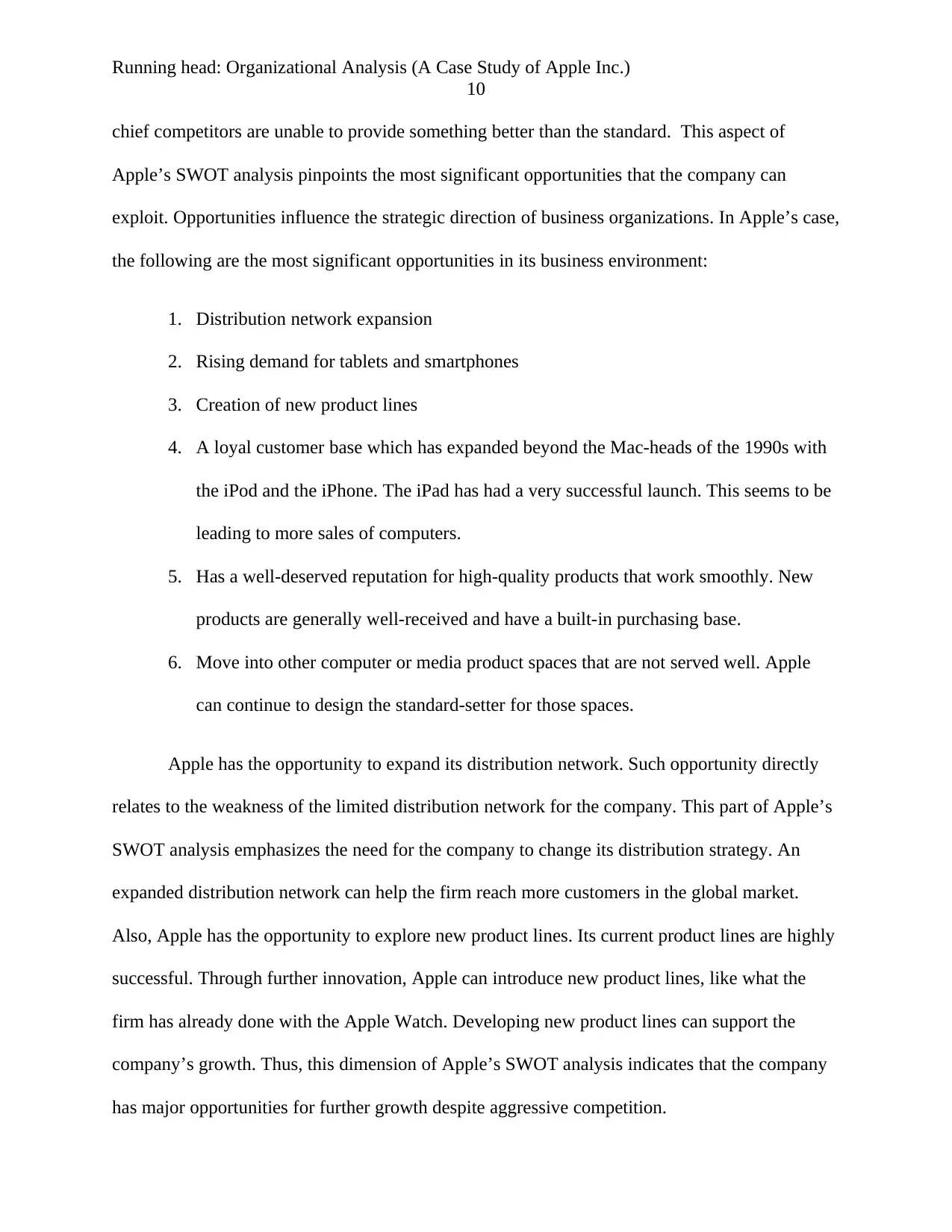
Running head: Organizational Analysis (A Case Study of Apple Inc.)
10
chief competitors are unable to provide something better than the standard. This aspect of
Apple’s SWOT analysis pinpoints the most significant opportunities that the company can
exploit. Opportunities influence the strategic direction of business organizations. In Apple’s case,
the following are the most significant opportunities in its business environment:
1. Distribution network expansion
2. Rising demand for tablets and smartphones
3. Creation of new product lines
4. A loyal customer base which has expanded beyond the Mac-heads of the 1990s with
the iPod and the iPhone. The iPad has had a very successful launch. This seems to be
leading to more sales of computers.
5. Has a well-deserved reputation for high-quality products that work smoothly. New
products are generally well-received and have a built-in purchasing base.
6. Move into other computer or media product spaces that are not served well. Apple
can continue to design the standard-setter for those spaces.
Apple has the opportunity to expand its distribution network. Such opportunity directly
relates to the weakness of the limited distribution network for the company. This part of Apple’s
SWOT analysis emphasizes the need for the company to change its distribution strategy. An
expanded distribution network can help the firm reach more customers in the global market.
Also, Apple has the opportunity to explore new product lines. Its current product lines are highly
successful. Through further innovation, Apple can introduce new product lines, like what the
firm has already done with the Apple Watch. Developing new product lines can support the
company’s growth. Thus, this dimension of Apple’s SWOT analysis indicates that the company
has major opportunities for further growth despite aggressive competition.
10
chief competitors are unable to provide something better than the standard. This aspect of
Apple’s SWOT analysis pinpoints the most significant opportunities that the company can
exploit. Opportunities influence the strategic direction of business organizations. In Apple’s case,
the following are the most significant opportunities in its business environment:
1. Distribution network expansion
2. Rising demand for tablets and smartphones
3. Creation of new product lines
4. A loyal customer base which has expanded beyond the Mac-heads of the 1990s with
the iPod and the iPhone. The iPad has had a very successful launch. This seems to be
leading to more sales of computers.
5. Has a well-deserved reputation for high-quality products that work smoothly. New
products are generally well-received and have a built-in purchasing base.
6. Move into other computer or media product spaces that are not served well. Apple
can continue to design the standard-setter for those spaces.
Apple has the opportunity to expand its distribution network. Such opportunity directly
relates to the weakness of the limited distribution network for the company. This part of Apple’s
SWOT analysis emphasizes the need for the company to change its distribution strategy. An
expanded distribution network can help the firm reach more customers in the global market.
Also, Apple has the opportunity to explore new product lines. Its current product lines are highly
successful. Through further innovation, Apple can introduce new product lines, like what the
firm has already done with the Apple Watch. Developing new product lines can support the
company’s growth. Thus, this dimension of Apple’s SWOT analysis indicates that the company
has major opportunities for further growth despite aggressive competition.
Paraphrase This Document
Need a fresh take? Get an instant paraphrase of this document with our AI Paraphraser
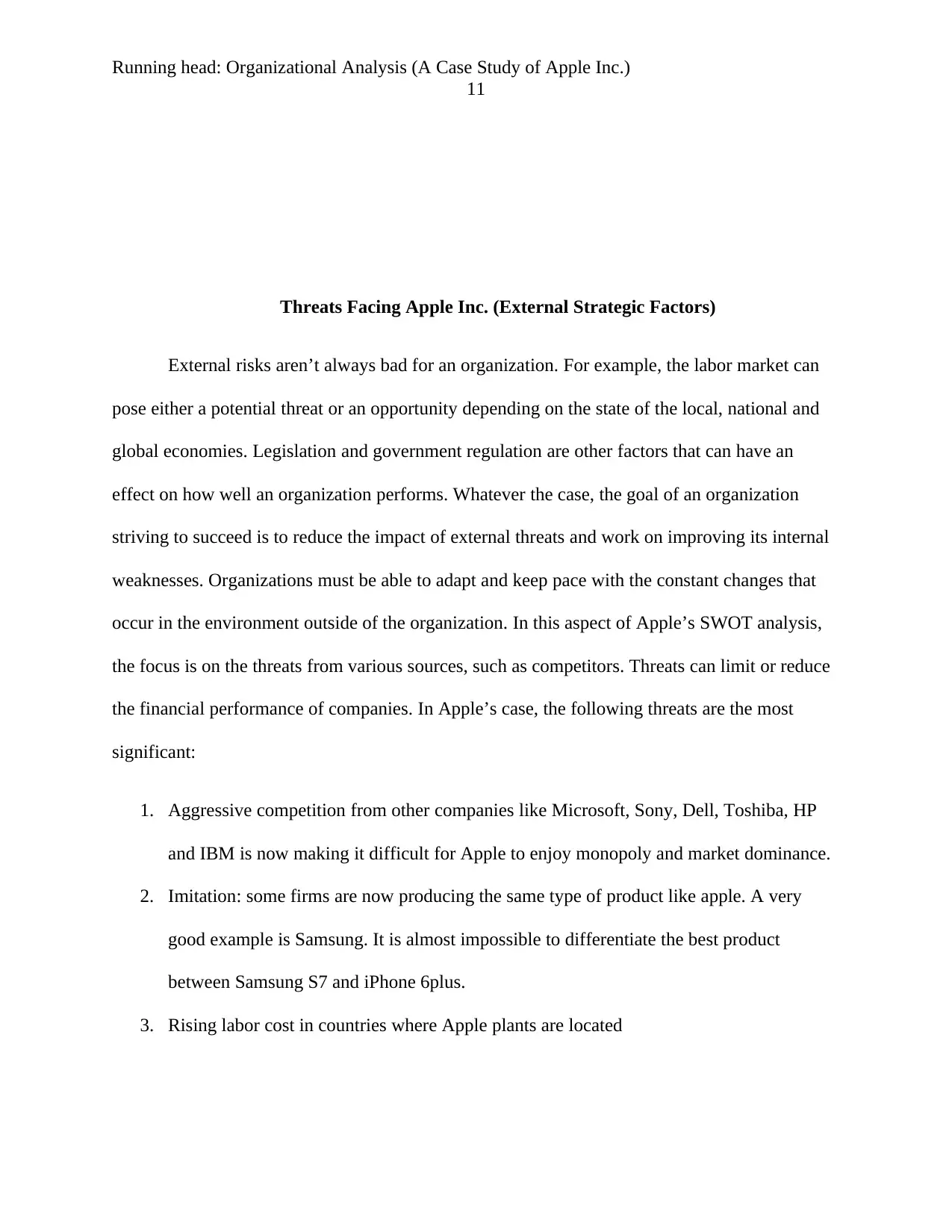
Running head: Organizational Analysis (A Case Study of Apple Inc.)
11
Threats Facing Apple Inc. (External Strategic Factors)
External risks aren’t always bad for an organization. For example, the labor market can
pose either a potential threat or an opportunity depending on the state of the local, national and
global economies. Legislation and government regulation are other factors that can have an
effect on how well an organization performs. Whatever the case, the goal of an organization
striving to succeed is to reduce the impact of external threats and work on improving its internal
weaknesses. Organizations must be able to adapt and keep pace with the constant changes that
occur in the environment outside of the organization. In this aspect of Apple’s SWOT analysis,
the focus is on the threats from various sources, such as competitors. Threats can limit or reduce
the financial performance of companies. In Apple’s case, the following threats are the most
significant:
1. Aggressive competition from other companies like Microsoft, Sony, Dell, Toshiba, HP
and IBM is now making it difficult for Apple to enjoy monopoly and market dominance.
2. Imitation: some firms are now producing the same type of product like apple. A very
good example is Samsung. It is almost impossible to differentiate the best product
between Samsung S7 and iPhone 6plus.
3. Rising labor cost in countries where Apple plants are located
11
Threats Facing Apple Inc. (External Strategic Factors)
External risks aren’t always bad for an organization. For example, the labor market can
pose either a potential threat or an opportunity depending on the state of the local, national and
global economies. Legislation and government regulation are other factors that can have an
effect on how well an organization performs. Whatever the case, the goal of an organization
striving to succeed is to reduce the impact of external threats and work on improving its internal
weaknesses. Organizations must be able to adapt and keep pace with the constant changes that
occur in the environment outside of the organization. In this aspect of Apple’s SWOT analysis,
the focus is on the threats from various sources, such as competitors. Threats can limit or reduce
the financial performance of companies. In Apple’s case, the following threats are the most
significant:
1. Aggressive competition from other companies like Microsoft, Sony, Dell, Toshiba, HP
and IBM is now making it difficult for Apple to enjoy monopoly and market dominance.
2. Imitation: some firms are now producing the same type of product like apple. A very
good example is Samsung. It is almost impossible to differentiate the best product
between Samsung S7 and iPhone 6plus.
3. Rising labor cost in countries where Apple plants are located
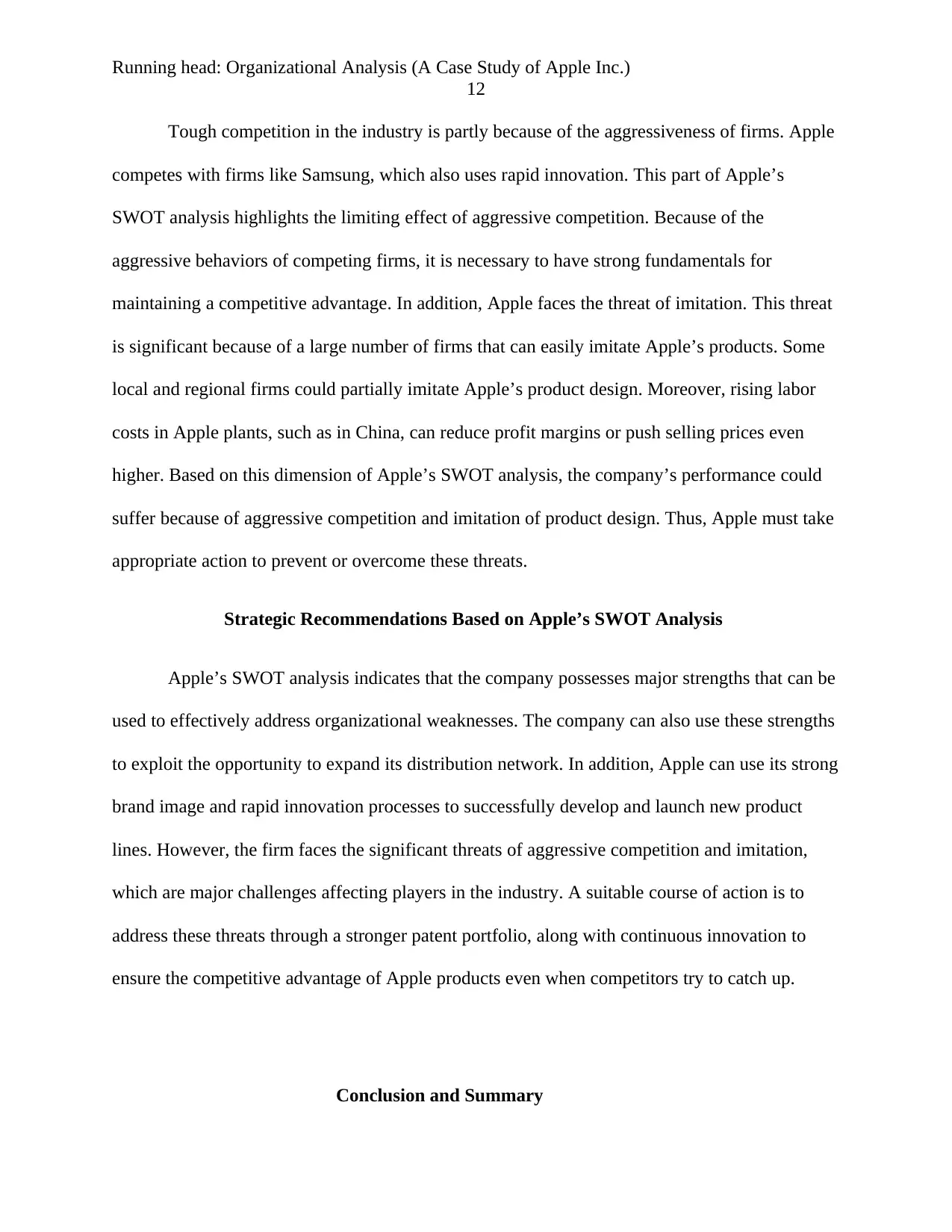
Running head: Organizational Analysis (A Case Study of Apple Inc.)
12
Tough competition in the industry is partly because of the aggressiveness of firms. Apple
competes with firms like Samsung, which also uses rapid innovation. This part of Apple’s
SWOT analysis highlights the limiting effect of aggressive competition. Because of the
aggressive behaviors of competing firms, it is necessary to have strong fundamentals for
maintaining a competitive advantage. In addition, Apple faces the threat of imitation. This threat
is significant because of a large number of firms that can easily imitate Apple’s products. Some
local and regional firms could partially imitate Apple’s product design. Moreover, rising labor
costs in Apple plants, such as in China, can reduce profit margins or push selling prices even
higher. Based on this dimension of Apple’s SWOT analysis, the company’s performance could
suffer because of aggressive competition and imitation of product design. Thus, Apple must take
appropriate action to prevent or overcome these threats.
Strategic Recommendations Based on Apple’s SWOT Analysis
Apple’s SWOT analysis indicates that the company possesses major strengths that can be
used to effectively address organizational weaknesses. The company can also use these strengths
to exploit the opportunity to expand its distribution network. In addition, Apple can use its strong
brand image and rapid innovation processes to successfully develop and launch new product
lines. However, the firm faces the significant threats of aggressive competition and imitation,
which are major challenges affecting players in the industry. A suitable course of action is to
address these threats through a stronger patent portfolio, along with continuous innovation to
ensure the competitive advantage of Apple products even when competitors try to catch up.
Conclusion and Summary
12
Tough competition in the industry is partly because of the aggressiveness of firms. Apple
competes with firms like Samsung, which also uses rapid innovation. This part of Apple’s
SWOT analysis highlights the limiting effect of aggressive competition. Because of the
aggressive behaviors of competing firms, it is necessary to have strong fundamentals for
maintaining a competitive advantage. In addition, Apple faces the threat of imitation. This threat
is significant because of a large number of firms that can easily imitate Apple’s products. Some
local and regional firms could partially imitate Apple’s product design. Moreover, rising labor
costs in Apple plants, such as in China, can reduce profit margins or push selling prices even
higher. Based on this dimension of Apple’s SWOT analysis, the company’s performance could
suffer because of aggressive competition and imitation of product design. Thus, Apple must take
appropriate action to prevent or overcome these threats.
Strategic Recommendations Based on Apple’s SWOT Analysis
Apple’s SWOT analysis indicates that the company possesses major strengths that can be
used to effectively address organizational weaknesses. The company can also use these strengths
to exploit the opportunity to expand its distribution network. In addition, Apple can use its strong
brand image and rapid innovation processes to successfully develop and launch new product
lines. However, the firm faces the significant threats of aggressive competition and imitation,
which are major challenges affecting players in the industry. A suitable course of action is to
address these threats through a stronger patent portfolio, along with continuous innovation to
ensure the competitive advantage of Apple products even when competitors try to catch up.
Conclusion and Summary
⊘ This is a preview!⊘
Do you want full access?
Subscribe today to unlock all pages.

Trusted by 1+ million students worldwide
1 out of 14
Related Documents
Your All-in-One AI-Powered Toolkit for Academic Success.
+13062052269
info@desklib.com
Available 24*7 on WhatsApp / Email
![[object Object]](/_next/static/media/star-bottom.7253800d.svg)
Unlock your academic potential
Copyright © 2020–2025 A2Z Services. All Rights Reserved. Developed and managed by ZUCOL.





